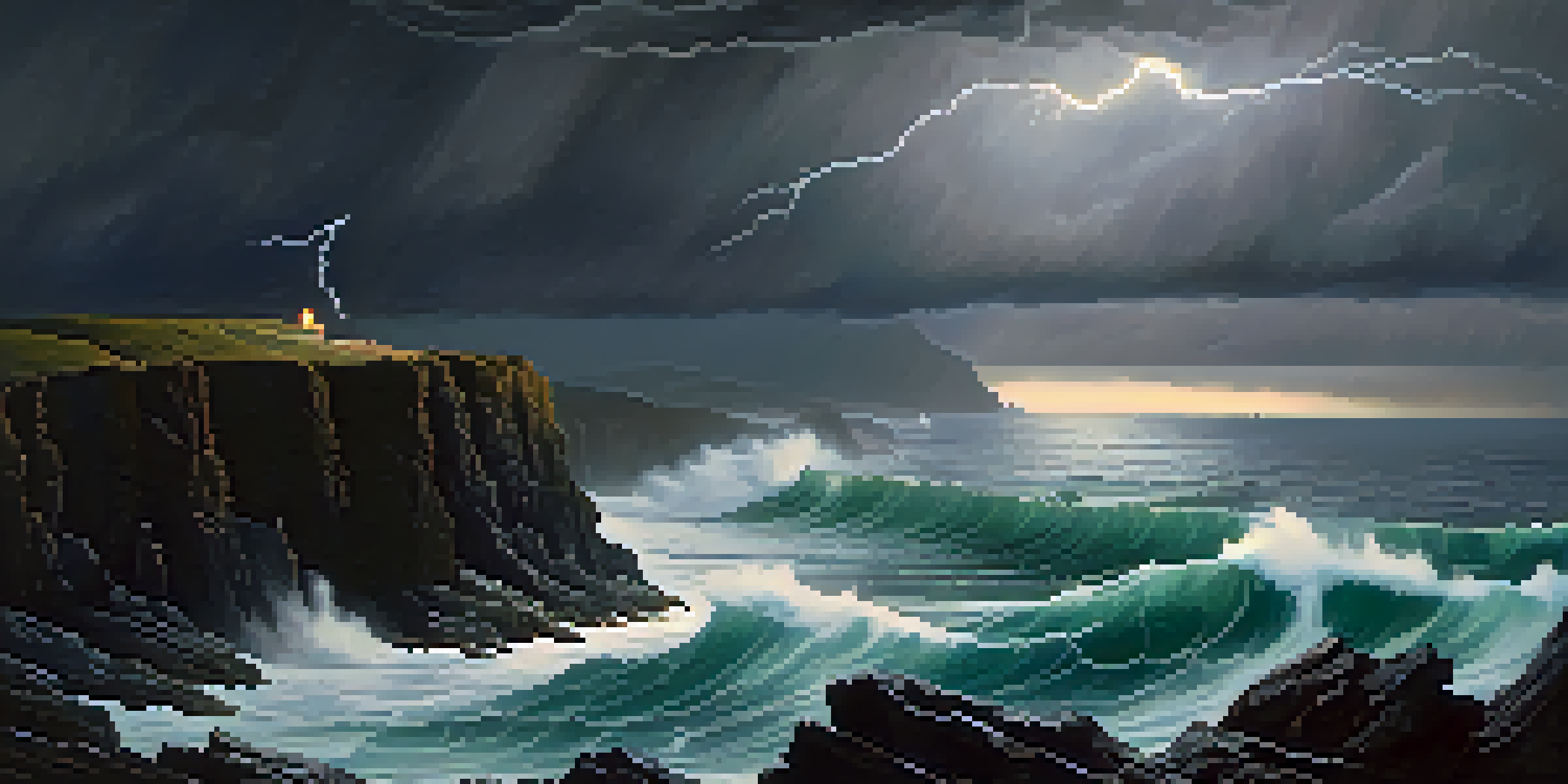Romanticism and Its Influence on Landscape Art

Understanding the Roots of Romanticism in Art
Romanticism emerged in the late 18th century as a reaction against the rationalism of the Enlightenment. Artists sought to express deep emotions and individual experiences, often turning to nature for inspiration. This movement valued intuition and imagination, leading to a richer, more personal interpretation of the world around them.
The artist is the creator of beautiful things. To reveal art and conceal the artist is art's aim.
At its core, Romanticism emphasized a connection to the sublime—those awe-inspiring aspects of nature that evoke both beauty and terror. Artists like Caspar David Friedrich and J.M.W. Turner captured these feelings in their landscapes, allowing viewers to experience nature's grandeur and its emotional weight. Through their work, they challenged traditional artistic conventions and paved the way for future movements.
The focus on individual expression and the emotional landscape became defining characteristics of Romantic art. This shift not only influenced how landscapes were painted but also encouraged artists to explore more profound themes, such as the passage of time and the insignificance of humanity in the face of nature's vastness.
Key Characteristics of Romantic Landscape Art
Romantic landscape art is distinguished by its dramatic use of light, color, and composition. Artists often employed vivid colors and contrasting tones to evoke strong emotions, drawing viewers into the scene. The landscapes themselves were often depicted as wild and untamed, reflecting the unpredictability of nature and human emotions.

Another hallmark of this period was the portrayal of nature as a powerful force. Artists like Turner often depicted storms, mountains, and turbulent seas to illustrate nature's overwhelming presence. This emphasis on the sublime not only showcased nature's beauty but also its dangers, inviting viewers to contemplate their relationship with the natural world.
Romanticism Celebrates Emotion
Romantic art emphasizes deep emotions and individual experiences, often using nature as a powerful backdrop.
Additionally, the inclusion of human figures in these landscapes often served to highlight humanity's vulnerability. By placing tiny figures against vast backdrops, artists emphasized the contrast between the human experience and the grandeur of nature, reminding us of our smallness in the grand scheme of things.
Romanticism's Influence on Notable Landscape Artists
Several artists stand out for their contributions to Romantic landscape art. Caspar David Friedrich, for instance, is renowned for his emotive compositions that often featured solitary figures gazing into expansive landscapes. His works invite introspection, making viewers ponder their own place within nature.
Nature is not a place to visit. It is home.
J.M.W. Turner, on the other hand, is celebrated for his ability to capture the ephemeral qualities of light and atmosphere. His use of color and dynamic brushwork creates a sense of movement and energy in his landscapes, which often evoke emotional responses from viewers. Turner's innovative approach laid the groundwork for future movements, including Impressionism.
These artists not only defined the Romantic era but also inspired countless others. Their exploration of emotional depth and the natural world continues to resonate in contemporary landscape art, demonstrating the enduring legacy of Romanticism in shaping artistic expression.
Romanticism Versus Enlightenment in Landscape Art
The Romantic movement stood in stark contrast to the Enlightenment, which prioritized reason and scientific understanding. While Enlightenment art often depicted landscapes as orderly and idealized, Romantic artists embraced the chaotic and emotional aspects of nature. This shift allowed for a more nuanced representation of the world.
Romanticism's focus on personal experience and emotional response encouraged artists to break free from the constraints of traditional techniques. They began to celebrate the imperfections of nature, opting for dramatic, sometimes turbulent scenes that reflected the complexities of human emotion. This departure from convention marked a significant evolution in the portrayal of landscapes.
The Sublime in Nature
The concept of the sublime is central to Romanticism, highlighting the awe and terror found in nature's grandeur.
The dialogue between these two movements highlights the transformative power of art. By valuing emotion over reason, Romanticism redefined how landscapes could be interpreted, allowing for a richer, more personal connection between the viewer and the artwork.
Nature as a Reflection of Human Emotion
In Romantic landscape art, nature often serves as a canvas for human emotions, reflecting feelings of joy, despair, and everything in between. Artists believed that the beauty and chaos of the natural world mirrored the complexities of human existence. This connection invites viewers to explore their own emotions through the lens of the landscape.
For example, a stormy sea can symbolize turmoil and conflict, while a serene sunset may evoke feelings of peace and introspection. By using nature as a metaphor for human experience, Romantic artists created a dialogue between the viewer and the artwork, allowing for a deeper understanding of both.
This practice of using landscape to express emotion has continued to influence artists across generations. Even today, many contemporary landscape artists draw inspiration from this Romantic tradition, exploring the intricate relationship between nature and the human spirit.
The Sublime: A Central Theme in Romanticism
The concept of the sublime is a cornerstone of Romanticism, encapsulating the awe and terror found in nature. This duality is vividly illustrated in the works of Romantic landscape artists, where majestic mountains or turbulent seas provoke both admiration and fear. The sublime experience encourages viewers to confront their emotions and perceptions of nature.
Artists like Friedrich and Turner understood the power of the sublime to evoke strong feelings. Their landscapes often provoke a sense of wonder, prompting viewers to contemplate their own insignificance against nature's grandeur. Such themes resonate deeply, inviting reflection on humanity's place within a vast, unpredictable world.
Legacy in Modern Art
Romanticism's influence persists in contemporary landscape art, where themes of emotion and humanity's relationship with nature continue to resonate.
The exploration of the sublime continues to be relevant in modern art, as artists grapple with environmental challenges and humanity's relationship with nature. By revisiting this theme, contemporary artists connect with the Romantic legacy, inviting audiences to engage with the emotional depth of the landscapes they create.
Legacy of Romanticism in Modern Landscape Art
The influence of Romanticism on landscape art is profound and enduring, shaping how artists approach their work even today. Many contemporary artists draw on the themes of emotion, the sublime, and humanity's relationship with nature, echoing the sentiments of their Romantic predecessors. This connection creates a rich tapestry of artistic expression that spans centuries.
Modern landscape art often reflects a deeper awareness of environmental issues, mirroring the Romantic emphasis on nature's power. Artists today continue to explore the emotional complexities of their surroundings, inviting viewers to engage with the landscapes in new and meaningful ways. This dialogue between past and present enriches our understanding of both art and the natural world.

Ultimately, the legacy of Romanticism serves as a reminder of the intricate relationship between art, nature, and human emotion. As we continue to navigate our complex world, the insights gleaned from Romantic landscape art remain relevant, inspiring artists and audiences alike to appreciate the beauty and complexity of the landscapes we inhabit.